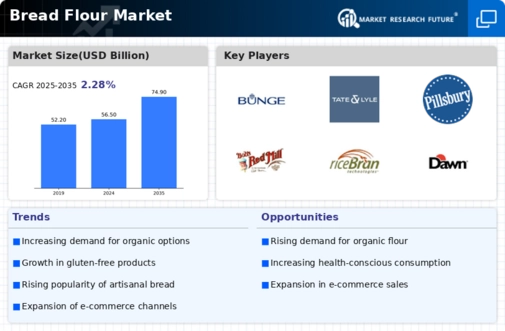Top Industry Leaders in the Bread Flour Market

Strategies Adopted by Bread Flour Key Players
The bread flour market is a dynamic and evolving sector, influenced by changing consumer preferences, technological advancements, and varying global economic conditions. As we assess the competitive landscape of this market, we explore various dimensions including key players, their strategies, market share determinants, emerging companies, industry news, investment trends, the overall competitive scenario, and recent developments as of 2023.
List of Key Players
The global bread flour market is characterized by the presence of both large multinational corporations and smaller, specialized companies. Prominent players include.
- General Mills, Inc. (U.S.)
- Associated British Foods plc. (the U.K.)
- Goodman Fielder (Australia)
- King Arthur Flour Company, Inc. (U.S.)
- Conagra Brands Inc. (U.S.)
- Archer Daniels Midland Company (U.S.)
These companies have established a strong foothold in the market through extensive product portfolios and widespread distribution networks.
To maintain and grow their market share, key players in the bread flour market have adopted various strategies. These include product innovation, such as the development of gluten-free or high-protein flour variants, catering to evolving consumer health trends. Mergers and acquisitions are also a common strategy for expanding market presence and gaining access to new markets. Additionally, companies are increasingly focusing on sustainability in sourcing and production, responding to consumer demand for environmentally responsible practices.
Factors for Market Share Analysis
Market share in the bread flour industry is influenced by a variety of factors. Product quality, brand recognition, distribution channels, price points, and adaptability to market trends are crucial. Furthermore, the ability to maintain consistent supply chain operations, especially in fluctuating economic conditions, plays a significant role in determining a company's market share.
New and Emerging Companies
The bread flour market is witnessing the entrance of new and innovative players who are challenging the status quo. These companies often focus on niche markets, such as organic or locally sourced flour, and leverage modern marketing techniques like social media to build brand awareness. Their agility and innovative approaches allow them to capture specific segments of the market.
Industry News and Current Company Updates
Recent industry news has highlighted a focus on sustainable and local sourcing of wheat, with companies investing in closer relationships with local farmers. There has also been an increase in the adoption of new technologies in milling and distribution to improve efficiency and reduce waste. Companies are also expanding their product lines to include specialty flours, catering to the growing segment of artisanal bakers and health-conscious consumers.
Investment Trends
The bread flour market is attracting investments in areas such as supply chain optimization, research and development in new flour varieties, and sustainable farming practices. Investors are particularly interested in companies that are innovating in product development and those aligning with global trends towards sustainability and health-consciousness.
Overall Competitive Scenario
The competitive scenario in the bread flour market is marked by a blend of traditional practices and innovative approaches. While larger companies benefit from scale and brand recognition, smaller companies compete based on product differentiation and niche market targeting. The market is also seeing a trend of collaboration between large and small players, especially in areas like sustainable sourcing and technological advancements.
Recent Developments
The bread flour market saw several key developments. One notable trend was the increasing focus on traceability and transparency in the supply chain. Companies are investing in technologies like blockchain to provide consumers with detailed information about the origin and processing of their flour.
Additionally, there was a significant shift towards the production of specialty flours, driven by consumer demand for diverse and health-oriented products. This includes the introduction of flours with specific nutritional profiles, such as increased fiber content, reduced gluten levels, or added functional ingredients like omega-3 fatty acids.
Sustainability continued to be a major focus, with companies increasing their investment in environmentally friendly farming practices and energy-efficient milling technologies. This shift is not only driven by consumer demand but also by regulatory pressures and the industry's recognition of its role in environmental stewardship.
Another development was the growth in strategic partnerships between flour producers and food manufacturers. These partnerships are aimed at co-developing products that meet specific consumer needs and preferences, allowing companies to leverage each other's strengths in product development and distribution.
Furthermore, the year 2023 witnessed the adoption of advanced analytics and artificial intelligence in production and supply chain management. These technologies are being used to optimize milling processes, improve quality control, and forecast demand more accurately, thereby reducing waste and increasing efficiency.











